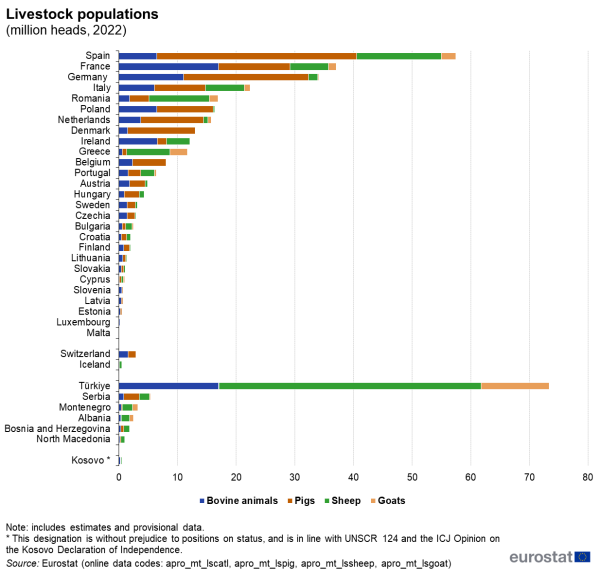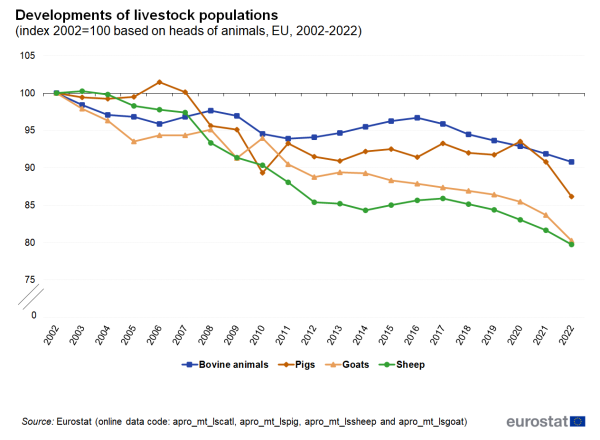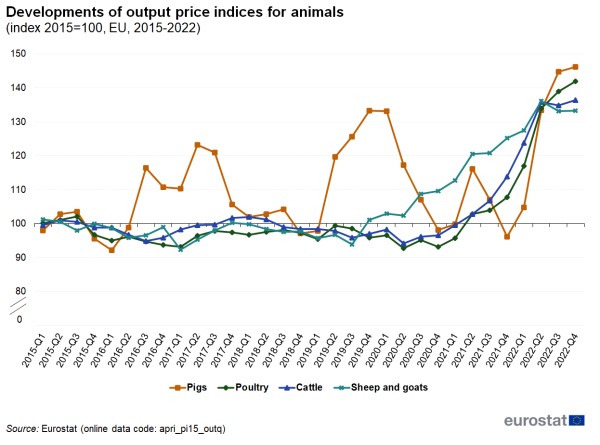Agricultural production - livestock and meat
Data extracted in September 2023.
Planned article update: October 2024.
Highlights
Meat production, EU, 2007-2022
This article presents information on livestock and meat production in the European Union (EU).
Editorial note: Throughout this article, which deals with time periods when the United Kingdom was a Member State of the European Union, the acronym EU, however, refers to EU-27, the post-Brexit composition of the European Union as of 1 February 2020.
The livestock population at any given moment describes the production system through the stocks of animals being farmed for their meat, for their milk or for reproduction.
The typical life-span of each of these groups in the cycle varies. For example, veal calves will typically be slaughtered within eight months, beef cattle within the first 2.5 years and dairy cows within 5 years.
Detailed figures on the age, sex, category and type of animals in production cycles are collected at a regional and national level. This is done through livestock surveys that are either carried out once or twice a year.
In this article only aggregated data for national livestock herds are analysed. More detailed figures for analysis are available in Eurostat's free, online database. It should be noted that the livestock in this article do not include poultry populations, which are considered as domestic fowl. Poultry statistics and the structure of hatcheries are covered in a separate article.
Full article
Livestock population
Majority of EU livestock populations held in just a few countries
The EU has a sizeable livestock population: at the end of 2022, there were 134 million head of pigs, 75 million head of bovine animals and 70 million head of sheep and goats.
A majority of the EU's livestock is held in just a few of the Member States (see Figure 1).
Spain accounted for about one-quarter of the EU's pig (25.4 %) and sheep (24.5 %) populations in 2022, while Greece had a similar share of the EU's goat population (26.3 %) and France a somewhat smaller share (22.7 %) of the bovine population.
Some EU countries are relatively specialised in terms of livestock farming. For example, Ireland accounted for 8.8 % of the EU's bovine animals in 2022 (slightly more than in Spain and Italy), while Denmark accounted for 8.6 % of the EU's pig population (only slightly less than in France). After Spain, the second and third largest sheep populations in the EU were in Romania (17.4 % of the EU total) and Greece (12.5 %).

(million heads, 2022)
Source: Eurostat (apro_mt_lscatl), (apro_mt_lspig), (apro_mt_lssheep) and (apro_mt_lsgoat)
Downward trend in livestock populations
During the past two decades, there has been a sharp reduction in livestock populations across the EU (see Figure 2). Between 2002 and 2022, the number of head of each livestock population decreased: the sharpest declines in percentage terms were recorded for the number of sheep and goats (both about 20 %), while the smallest rate of decline was in bovine animal numbers (about 9 %).
Looking in more detail at developments between 2021 and 2022, the population of bovine animals in the EU decreased 1.2 % while there were sharper rates of decline for sheep (down 2.4 %), goats (down 4.1 %) and pigs (down 5.1 %).

(index 2002=100 based on heads of animals, EU, 2002-2022)
Source: Eurostat (apro_mt_lscatl), (apro_mt_lspig), (apro_mt_lssheep) and (apro_mt_lsgoat)
In contrast to the relative price stability recorded for poultry and cattle during the period between 2015 and 2020 (see Figure 3), their output prices rose strongly in 2021 and especially 2022 (with annual increases in 2022 of 29.8 % for poultry and 25.6 %). Price developments for sheep and goats were also relatively moderate in the earlier years but increased in 2020 and rose at a faster pace in 2021 and 2022. There was more volatility to price developments for pigs (in contrast to developments for other types of livestock): output prices fluctuated throughout the period under consideration but rose particularly strongly in 2022, up 26.4 %.

(index 2015=100, EU, 2015-2022)
Source: Eurostat (apri_pi15_outq)
Meat production
Better animal welfare improves animal health and food quality. Within the context of the EU's Farm to Fork Strategy, the European Commission plans to revise legislation concerning the slaughter of animals so that it is aligned with scientific evidence, broadening its scope, making it easier to enforce, and ultimately ensuring a higher level of animal protection/welfare.
Data is collected on the number and weight of carcasses at slaughterhouses, whose meat is deemed fit for human consumption. In this article, 'meat' should be understood as the carcass weight from slaughterhouses.
Pig meat
Pig meat production fell back sharply in 2022 from its peak in 2021
The EU produced a provisional 22.1 million tonnes of pig meat in 2022. This was 1.3 million tonnes less than the peak level in 2021, the equivalent of a 5.7 % decline. To put this in context, production in 2022 was almost back to the low of 2009.
The two main pig meat producing countries in the EU are Spain (5.1 million tonnes in 2022) and Germany (4.5 million tonnes). After eight successive years of growth in Spain, pig meat production declined moderately (-2.2 %) in 2022. Pig meat production in Germany declined for a sixth consecutive year but at an accelerated rate in 2022 (-9.6 %). There were also lower pig meat production levels in 2022 among all the other main EU producer countries, with the strongest rates of decline being in Poland (-9.2 %) and Denmark (-6.6 %).
Poultry meat
Poultry meat production in 2022 fell back further from its high in 2020
The EU produced an estimated 13.0 million tonnes of poultry meat in 2022, which was the equivalent of an estimated 1.5 % decline on the amount in 2021. This reduction should be seen against the backdrop of a strong upward trend in production through until 2020. The level of poultry meat production in 2022 remained 3.2 million tonnes more than in 2007.

Source: Eurostat (apro_mt_lscatl), (apro_mt_lspig), (apro_mt_lssheep) and (apro_mt_lsgoat)
In 2022, the main poultry meat producers in the EU were Poland (representing 21.0 % of EU production, with 2.7 million tonnes), Spain (12.6 %, with 1.6 million tonnes), Germany (11.9 %, with 1.5 million tonnes), France (11.6 %, with 1.5 million tonnes) and Italy (9.3 %, with 1.2 million tonnes). Bucking the general trend, poultry meat production in Poland rose sharply (up 7.5 %) to a new high in 2022 and remained relatively steady in Spain (up +0.6 %). By contrast, production levels were sharply lower in France (-8.7 %) and Italy (-11.8 %).
Veal and beef
Beef is the meat from the slaughter of bovine animals of at least 1 year. Certain cattle breeds are reared specifically for their beef, although beef can also come from dairy cattle. In this article, veal is considered as the meat from bovine animals younger than 1 year (usually male calves and young cattle). Male calves from dairy cows are of no use for producing milk and their growth potential for producing beef meat is not optimal.
Lower level of production of bovine meat in 2022
The EU produced a provisional 6.6 million tonnes of bovine meat (beef and veal carcasses) in 2022, which was about 160 000 tonnes less than in 2021 (equivalent to decline of 2.4 %). This downturn in production for a fourth consecutive year has now offset the higher production that came after the end of milk quotas on 31 March 2015 and the associated rise in cow slaughter as some of the smallest farms abandoned dairy production (see Figure 4).
About half of the EU's beef in 2022 (see Figure 5) was produced in three countries: France (20.8 %), Germany (16.5 %) and Italy (11.6 %).
About 70 % of the EU's veal meat was also produced in three countries: the Netherlands (26.9 %), Spain (22.9 %), and France (18.9 %).
Sheep and goats' meat
Small decline in production in 2022
The EU produced an estimated 0.5 million tonnes of sheep and goats' meat in 2022, an estimated 1.1 % more than in 2021. Sheep meat accounted for the vast majority (about 90 %) of the combined total output.
Three-quarters of the EU's sheep meat in 2022 was produced in Spain (27.8 %), France (18.2 %), Ireland (14.5 %) and Greece (14.3 %). Among EU countries, the main producers of goat meat are Greece and Spain.
Source data for tables and graphs
Data sources
Livestock and meat statistics
Livestock and meat statistics are collected by EU Member States under Regulation (EC) No 1165/2008, which covers bovine, pig, sheep and goat livestock; slaughtering statistics on bovine animals, pigs, sheep, goats and poultry; and production forecasts for beef, veal, pig meat, sheep meat and goat meat. Livestock surveys cover sufficient agricultural holdings to account for at least 95 % of the national livestock population, as determined by the last survey on the structure of agricultural holdings.
Bovine and pig livestock statistics are produced twice a year, with reference to a given day in May/June and a given day in November/December. Those EU Member States whose bovine animal populations are below 1.5 million head or whose pig populations are below 3.0 million head may produce these statistics only once a year, with reference to a given day in November/December. The November/December results are available for all EU Member States and are used in this article.
Sheep livestock statistics are only produced once a year, with reference to a given day in November/December, by those EU Member States whose sheep populations are 500 000 head or above; the same criteria and thresholds apply for statistics on goat populations.
Agricultural price statistics
EU agricultural price statistics are based on voluntary agreements between Eurostat and the Member States.
National statistical institutes or Ministries of Agriculture are responsible for collecting absolute prices and calculating corresponding average prices for their country, as well as for calculating price indices and periodically updating the weights.
Price indices are reported quarterly and annually. Absolute prices are reported annually. The agricultural prices expressed in national currency are converted into euro by Eurostat using fixed exchange rates or average financial market exchange rates (annual), in order to allow comparisons between the Member States. Eurostat is responsible for calculating indices for the EU.
Context
Statistics on livestock and meat production (based on the slaughter of animals fit for human consumption) give some indication of supply-side developments and adjustments, which are important for monitoring the common agricultural policy (CAP).
One of the objectives of the first CAP was to secure the availability of food supplies for the people of the then European Economic Community. The CAP has evolved, requiring more agricultural market transparency for all actors and EU citizens. Statistics for livestock and meat, as with other agricultural products, help provide feedback on market signals.
In order to limit uncertainty, EU institutions in charge of market support interpret the market signals using livestock numbers for their forecasts. The number of breeders (for dairy or meat production) as well as animal stocks being grown and fattened, contribute to preparing measures that ensure a more stable — or at least more secure — market, which aims to benefit both EU consumers and farmers.
The EU has introduced a range of legislation covering the traceability of livestock, in part as a response to various food safety concerns. For most animal species, this traceability concerns a system of identification — usually through ear-tags or tattoos — coupled with a national register that details animals as they are reared, held or handled at each stage of the food chain. The European Commission has been active in harmonising animal health measures and systems of disease surveillance, diagnosis and control; it has also developed a legal framework for trade in live animals and animal products. Ensuring the high quality of food is one of the various challenges to be met in order to secure this food supply.
As part of the EU's Farm to Fork Strategy, the European Commission is in the process of drafting a proposal to revise the Feed Additives Regulation ((EC) No 1831/2003) with the goal of reducing the environmental impact of livestock farming. For example it will examine rules to lessen dependency on feed materials grown on deforested land, and aim to replace these with EU-grown plant proteins and alternative feed.
Direct access to
- Agriculture (t_agri), see:
- Agricultural production (t_apro)
- Livestock and meat (t_apro_mt)
- Agricultural prices and price indices (t_apri)
- Producer price indices, animals and animal products (tag00050)
- Agriculture (agri), see:
- Agricultural production (apro)
- Poultry farming (apro_ec)
- Livestock and meat (apro_mt)
- Meat production (apro_mt_p)
- Livestock (apro_mt_ls)
- Structure of rearing (apro_mt_str)
- Agriculture, forestry and fishery statistics — 2020 edition (statistical book)
- Animal production (ESMS metadata file — apro_anip_esms)
- Regulation (EC) No 617/2008 of 27 June 2008 laying down detailed rules for implementing Regulation (EC) No 1234/2007 as regards marketing standards for eggs for hatching and farmyard poultry chicks
- Regulation (EC) No 1165/2008 of the European Parliament and of the Council of 19 November 2008 concerning livestock and meat statistics
- Summaries of EU Legislation: Statistics — livestock and meat under the common agricultural policy
- European Commission — Agriculture and rural development — food, farming, fisheries
- European Commission — Agriculture and rural development — beef
- European Commission — Agriculture and rural development — pork
- European Commission — Agriculture and rural development — poultry
- European Commission — Agriculture and rural development — lamb, mutton and goatmeat
- European Commission — Agriculture and rural development — short- and medium term outlook and market reports for EU arable crops, dairy and meat markets
